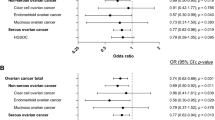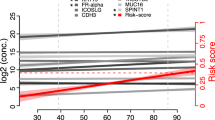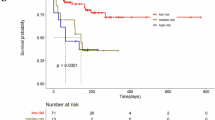Abstract
Of 230 women referred to a familial ovarian cancer clinic, 196 (85%) completed a questionnaire before they attended. The data collected included pre-counselling risk perceptions and an assessment of distress. Respondents were more likely to underestimate (44%) than overestimate (19%) their risk. Those with a family history of breast and ovarian cancer (HBOC) were particularly likely to underestimate their ovarian cancer risk. The variables assessed in this study – sociodemographic, family history, distress, anxiety proneness, coping style and beliefs about health control – explained little of the observed variation in accuracy of risk perception. On the General Health Questionnaire (GHQ-30) 30% of the sample obtained scores above the cut-off (≥ 6) recommended for screening for ‘case-level’ psychological distress. Women exhibiting case-level distress were more likely to overestimate their risk (OR = 2.3). On univariate analysis low internal locus of control was associated with ‘case-level’ distress (P = 0.008). On multiple regression the best predictors of ‘caseness’ were high-trait anxiety, being a graduate and inaccurate risk perception. There was no difference in the level of distress shown by women with HBOC vs. those with a history of ovarian cancer only. Implications of these findings for the counselling needs of the women are discussed. The effectiveness of the clinic in improving the accuracy of risk perceptions and relieving distress is being assessed. © 2001 Cancer Research Campaign
Similar content being viewed by others
Article PDF
Change history
16 November 2011
This paper was modified 12 months after initial publication to switch to Creative Commons licence terms, as noted at publication
References
Audrain J, Schwartz MD and Lerman C (1997) Psychological distress among women seeking genetic counselling for breast–ovarian cancer risk: the contribution of personality and appraisal. Ann Behav Med 19: 370–377
Cox B, Blaxter M and Buckle A (1987). The Health and Lifestyle Survey, Cambridge: Health Promotion Research Trust
Cull A, Anderson EDC, Campbell S, Mackay J, Smyth E and Steel M (1999) The impact of genetic counselling about breast cancer risk on women’s risk perceptions and levels of distress. Br J Cancer 79: 501–508
Cuzick J (1985) A Wilcoxon type test for trend. Stat Med 4: 87–90
Daly MB and Lerman C (1993) Ovarian cancer risk counselling: a guide for the practitioner. Oncology 7: 27–34
Evans DGR, Burnell LD, Hopwood P and Howell A (1993) Perception of risk in women with a family history of breast cancer. Br J Cancer 67: 612–614
Evans DGR, Blair V, Greenhalgh R, Hopwood P and Howell A (1994) The impact of genetic counselling on risk perception in women with a family history of breast cancer. Br J Cancer 70: 934–938
Ford D, Easton DF and Peto J (1995) Estimates of the gene frequency of BRCA1 and its contribution to breast and ovarian cancer incidence. AM J Human Genetics 57: 1457–1462
Fry A, Busby-Earle C, Rush R and Cull A Long term psychosocial adjustment to prophylactic oophorectomy in women at increased risk of ovarian cancer. PsychoOncology,
Goldberg DO and Williams P (1988). GHQ: A Users Guide to the General Health Questionnaire, NFER-Nelson: Windsor
Green J, Murton F and Stratham H (1993) Psychosocial issues raised by a familial ovarian cancer register. J Med Genet 30: 575–579
Hallowell N and Richards MPM (1997) Understanding life’s lottery: an evaluation of studies of genetic risk awareness. J Health Psychol 2: 31–43
Jacobs I and Lancaster J (1996) The molecular genetics of sporadic and familial epithelial ovarian cancer. Int J Gynaecol Cancer 6: 337–355
Jacobs I, Mackay J and Skates S (1997). UKCCCR National Familial Ovarian Cancer Screening study, OCS Study Registration Centre, Addenbrooke's Hospital: Cambridge
Kash KM and Dabney MK Ortega-Vardejo (2000). Group intervention for women at genetic risk for breast cancer, (March 9th, 2000).
Knight RG, Waal Manning HJ and Spears GF (1983) Some norms and reliability data for the State Trait Anxiety Inventory and Zung Self Rating Depression Scale. Br J Clin Psychol 22: 245–249
Lloyd S, Watson M and Waites B (1996) Familial breast cancer: a controlled study of risk perception psychological morbidity and health beliefs in women attending for genetic counselling. Br J Cancer 74: 482–487
Mackay J, Crosbie AEC, Steel CM, Smart GE and Smyth JF (1995) Clinical and ethical dilemmas in familial ovarian cancer. Chapter 8 In: Sharp F, Blackett A, Leahe R, Berek J (eds) Ovarian Cancer, London: Chapman-Hall
Marks G, Richardson JL, Graham JW and Levine A (1986) Role of health locus of control beliefs and expectations of treatment in adjustment to cancer. J Pers Soc Psychol 51: 443–450
Miller SM (1987) Monitoring and blunting: validation of a questionnaire to assess styles of information seeking under threat. J Pers & Soc Psychol 52: 345–353
Rees G, Fry A, Cull A . A family history of breast cancer. Women’s experiences from a theoretical perspective. Soc Sci & Med,
Robinson GE, Rosen BP, Bradley LN, Rockfert WG, Carr ML, Cole DEC and Murphy KJ (1997) Psychological impact of screening for familial ovarian cancer: Reactions to initial assessment. Gynaecol Oncol 65: 197–205
Schwartz MD, Lerman C, Miller SM, Daly M and Maisny A (1995) Coping predisposition, perceived risk and psychological distress among women at increased risk for ovarian cancer. Health Psychology 14: 3) 232–235
Sheppard R, Fry A, Rush R, Steel CM and Cull A Women at risk of ovarian cancer: attitudes towards and expectations of the familial ovarian cancer clinic. Familial Cancer,
Spielberger C (1983) Manual for the State Trait Anxiety Inventory. Consulting Psychologists Press: Palo Alto, Ca
Steptoe A (1989) An abbreviated version of the Miller Behavioural Style Scale. Br J Clin Psychol 28: 183–184
Stratton JF, Gayther SA, Russell P and Dearden J (1997) Contribution of BRCA1 mutations to ovarian cancer. N Eng J Med 336: 1125–1130
Wallston KA and Wallston BS (1978) Development of the Multidimensional Health Locus of Control Scales. Health Educ Monogr 6: 2 160–170
Wardle J (1995) Women at risk of ovarian cancer. J Natl Cancer Inst Monogr No 17: 81–85
Author information
Authors and Affiliations
Rights and permissions
From twelve months after its original publication, this work is licensed under the Creative Commons Attribution-NonCommercial-Share Alike 3.0 Unported License. To view a copy of this license, visit http://creativecommons.org/licenses/by-nc-sa/3.0/
About this article
Cite this article
Cull, A., Fry, A., Rush, R. et al. Cancer risk perceptions and distress among women attending a familial ovarian cancer clinic. Br J Cancer 84, 594–599 (2001). https://doi.org/10.1054/bjoc.2000.1651
Received:
Revised:
Accepted:
Published:
Issue date:
DOI: https://doi.org/10.1054/bjoc.2000.1651
Keywords
This article is cited by
-
Risk Perception and Psychological Distress in Genetic Counselling for Hereditary Breast and/or Ovarian Cancer
Journal of Genetic Counseling (2017)
-
Population-based genetic risk prediction and stratification for ovarian cancer: views from women at high risk
Familial Cancer (2015)
-
Monitoring style of coping with cancer related threats: a review of the literature
Journal of Behavioral Medicine (2014)
-
Assessment of palliative care cancer patients’ most important concerns
Supportive Care in Cancer (2011)
-
Australian women’s awareness of ovarian cancer symptoms, risk and protective factors, and estimates of own risk
Cancer Causes & Control (2010)



